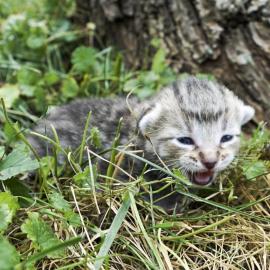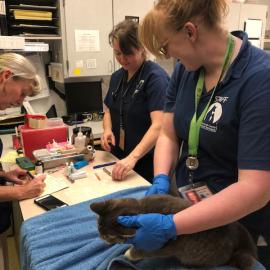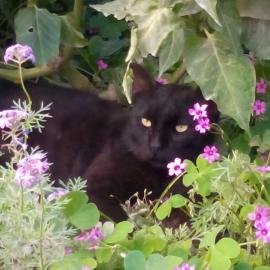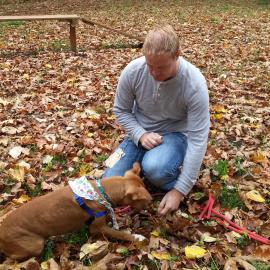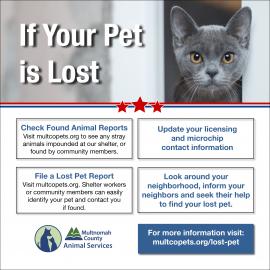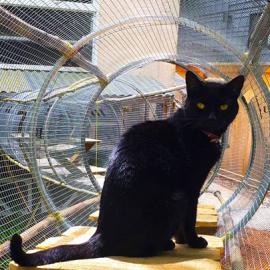流浪猫信息
Limited Intake for Cats & Kittens
流浪动物收容
帮助链接
数据
- 每年有3,000到4,000只猫进入Multnomah县动物服务中心。
- 这些猫大多是在一年中较为温暖的月份来到这里的,这些月份也被称为小猫季。
- 为了能够尽可能拯救更多的猫,我们请求公众的帮助。

How to Help Outdoor Cats
您能帮上什么忙?
如果您的周边有一只流浪猫,不要将它预判为无家可归的猫
根据Multnomah县条例,猫可以“自由活动”。然而,如果一只猫在您的领地上, 您可以这样驱赶它。
诱捕/绝育/放归(TNR)
如果您周边有很多流浪猫,考虑实施诱捕/绝育/放归(TNR)计划。该人道计划的效果已经在全国范围内得到证明,能够缓解许多与流浪猫和/或野猫相关的问题。
- Oregon野猫联盟(FCCO)是一个TNR计划,向由看护者喂养的野猫和流浪猫提供以捐赠为基础的绝育服务。如果您正在喂养野猫或流浪猫,请致电FCCO(503) 797-2606,或者您也可以在他们的网站上填写一份看护者申请
- 美国防止虐待动物协会(ASPCA)野猫常见问题解答
- 美国动物保护协会(The Humane Society of the United States,HSUS)对TNR的立场
考虑领养流浪小猫(和它们的母亲),直到它们的体重达到至少2.5lb
体重满2.5lb的小猫可以安全接受绝育手术,然后被温暖的家庭领养。尚未断奶就离开母亲的小猫通常被称为人工喂养小猫。少数机构可能有能力接收人工喂养小猫,或者为您提供用奶瓶喂养小猫的指导。想了解更多发现小猫后的处理方法,请浏览我们的“如果您发现了小猫”页面。
做一名倡导者!
如果您带来了一只流浪猫,请记下它的动物编号,并打去电话了解它的进展。如果因为空间、压力或健康问题阻碍猫咪被领养,请您同意寄养、领养或出售猫咪。
让您的“猫咪安全在家”™
猫咪安全在家™是一个鼓励猫主人把猫安全地养在家里的活动。室内猫可以在室外的围栏里享受户外生活,您也可以训练它们戴着牵引绳出门。不让猫咪自由游荡,可以防止它遭遇危险、疾病、野生动物的捕食或迷路。这也有助于减少猫对当地野生动物的影响。在Portland Audubon野生动物护理中心(Portland Audubon Wildlife Care Center)接受治疗的动物中,超过40%都与猫的伤害有关。春天时让猫呆在家里尤其重要,因为那时幼鸟正在学习飞行,非常容易受到伤害。想了解更多关于猫和野生动物的信息,请访问Portland Audubon协会(Audubon Society of Portland)。美国人道协会(HSUS)有关于如何将您的户外猫永久留在室内的指导方针。
给您的宠物做绝育手术,并劝说别人也这样做
Portland动物收容所联盟(Animal Shelter Alliance of Portland, ASAP)确定,只是为了控制猫的数量,就需要连续五年每年额外给10,000只猫进行绝育。请不要犹豫!查看我们的绝育资源页面!
为您的猫和狗办理宠物证
相关费用将用于帮助社区中无家可归的流浪动物。
永远不要遗弃您的猫
如果您无法继续照顾您的猫, 学习如何为您的猫找一个新家。
遗弃猫是违法且不人道的。这是一个绝对不可以接受的解决方案。请不要增加流浪猫的数量。
About Our Cat Intake Policy
Following recommendations from the National Animal Care & Control Association (NACA), Multnomah County Animal Services (MCAS) only accepts outdoor adult cats* that are:
- Sick
- Injured
- Abandoned, such as being left in a crate or in a vacated building.
- In immediate danger due to cruelty, neglect, and similar circumstances.
- Kittens between the ages of six (6) and twelve (12) weeks old
Learn what to do if you find kittens, and how to know how old they are.
Why doesn’t MCAS take healthy outdoor cats?
New findings from NACA show that impounding healthy adult cats is not the best way to help the cats, their owners, or the neighborhoods where they live.
Impoundment of healthy adult cats:
Reduces the likelihood of reuniting families with pets
Lost cats are 10-50 times more likely to be reunited with their owners if they stay where they were found instead of being brought to an animal shelter. They are more likely to return on their own or be found by their families.
Affects low-income and marginalized community members the most
Low-income pet owners face barriers to visit animal shelters due to transportation, limited time during business hours, or other costs, and are less likely to call or visit animal shelters to reclaim lost pets.
Reduces the capacity of Animal Services to respond to critical community needs
Shelters with a high cat population can quickly become overwhelmed and overcrowded, and have less capacity to provide critical care and outcomes for abused, neglected, injured, or sick animals, and support for the pets of families in crisis.
Can increase cat populations and their negative impact
Because removing cats may lead to different cats moving in (especially if there is a food source), it is not an effective way to manage the outdoor cat population.
Doesn’t solve nuisance behaviors
Removing cats because of nuisance behaviors is less likely to solve core problems like cats feeding from open garbage containers that may be attracting cats, rodents, and other animals.
TNR programs that leave cats where they are and manage their environment are better able to solve nuisance issues with cats
